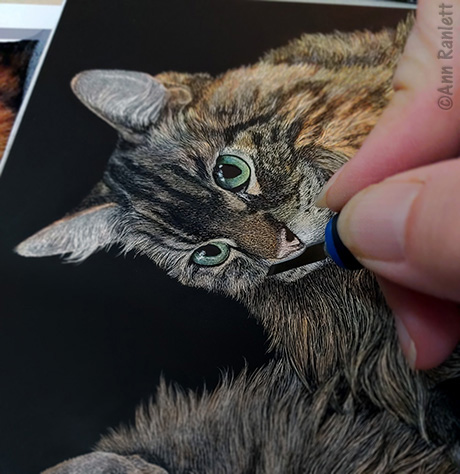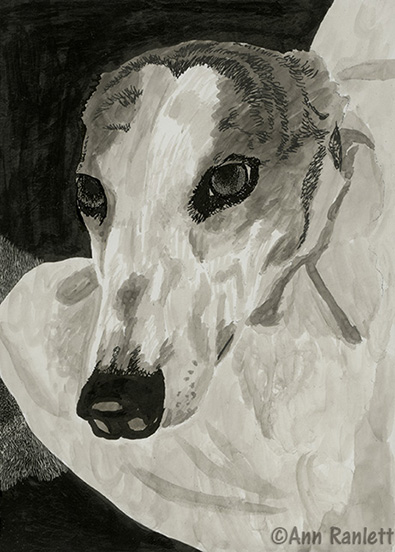Scratchboard is a clay-coated surface that is scratched with a knife or other abrasive tool to render detail and texture. Boards are either black or white. The majority of scratchboard artists use Ampersand‘s archival boards: Scratchbord™ (black) or Claybord™ (white).
On the black boards, the artist ‘draws white with a knife’. Any area that is white (clay) will accept color, allowing the artist to color the scratched work in its entirety, in select areas, or leave it black & white. Colored ink, watercolor, or fluid acrylics may be used. Color can be added with a paintbrush and/or airbrush. A wash of diluted black ink may be used to create grey values. On a white board, the artist adds black or colored ink first, and then scratches.
Either type of board can be re-inked and re-scratched multiple times to build texture, value, tone & detail. Re-inking can be done with a pen, brush or airbrush.
Scratchboard is a time-consuming process, but a professional quality board is actually quite forgiving and versatile. Although furred and feathered subjects are a natural for this surface, any subject that can be rendered in other mediums can be rendered in scratchboard.
Why Scratchboard?
Ann says:
“I fell in love (I’m not exaggerating) with scratchboard when I took a workshop taught by Trudy Nicholson at a Guild of Natural Science Illustrators conference in the late ’90s. I had been drawing with pen and ink for many years, and enjoyed it immensely – I liked the challenge of rendering a subject using just black and white. The problem with pen and ink, though, is that once the ink is on the paper, it’s there for good. Changes are very difficult to make. If the drawing is for print reproduction, corrections can be made, but they’re still visible on the original. With scratchboard however, the thickness of the coating allows for many revisions. Using white scratchboard as a drawing surface for pen & ink also allows for a greater variation of line and value and creation of finer detail than a paper surface does. For example, I can scratch a white whisker on a black area with the thin edge of a knife. Trying to draw that in pen and ink on paper would require drawing black around the white whisker to leave the paper showing through – that’s very difficult to do!
Over the years since that workshop, I’ve switched from using the white surface for most of my work, to the black surface, adding color to many of my drawings. I’ll still use a white surface when the composition calls for limited areas of black. It’s easier to add black selectively than to completely remove any traces of black from large areas that should be white or light.”

Color added, scratching the color to fine-tune.
See the completed portrait here.

Very early stage: elements blocked in with India ink & ink washes.
See the completed portrait here.



